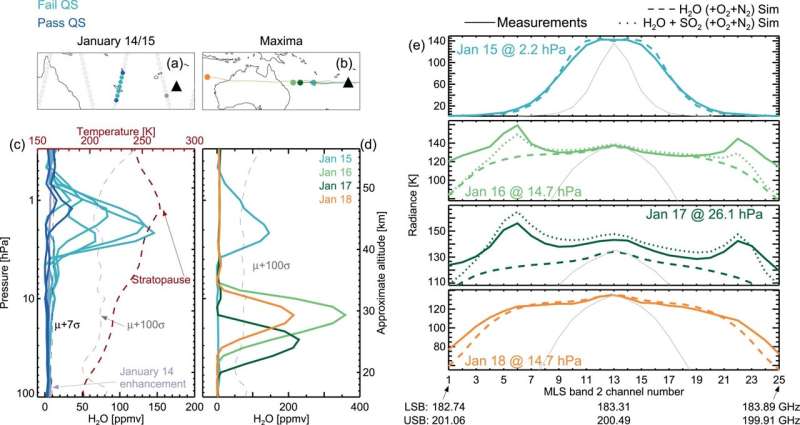August 2, 2022 report
Water in atmosphere from Tonga eruption may weaken ozone layer

A team of researchers at the California Institute of Technology's Jet Propulsion Laboratory, working with a colleague from the University of Edinburgh, has found evidence suggesting that the Hunga Tonga-Hunga Ha'apai eruption earlier this year may have pushed so much water into the atmosphere that there is a possibility it could weaken the Earth's ozone layer. In their paper published in the journal Geophysical Research Letters, the group studied data from satellites to measure how much water was launched into the atmosphere and believe it could lead to weakening of the ozone layer.
The Tonga eruption occurred January 15, on and below the seabed in the Pacific Ocean near Tonga. In addition to spewing a variety of gases into the ocean, some of which eventually made their way into the atmosphere, the blast also blew massive amounts of ocean water skyward—high enough that a lot of it made it into the stratosphere. Water at such heights, the researchers note, could be there for many years—perhaps decades.
The work involved gathering data from satellites that had captured the eruption via sensors. In addition to dramatic video imagery, the researchers also found measurements of released sulfur dioxide. Comparing it with other eruptions, they found the amount was not unusual. It was when they checked how much water was blown into the atmosphere that they found something surprising: It was a larger amount than had ever been recorded before, and it was blown higher than ever observed before—some of it into the mesosphere. Their calculations showed that the total amount of water that made its way into the stratosphere was approximately 146 Tg. Put another way, they suggest that seawater from the eruption increased the total amount of water in the stratosphere by approximately 10%.
The researchers note that while the sulfur ejected into the atmosphere could have a small cooling effect on the planet, the water will have a warming effect because water absorbs energy from the sun. They also note that when water molecules mix with oxygen atoms, hydroxide is produced, which could lead to reductions in ozone.
More information: L. Millán et al, The Hunga Tonga‐Hunga Ha'apai Hydration of the Stratosphere, Geophysical Research Letters (2022). DOI: 10.1029/2022GL099381
Journal information: Geophysical Research Letters
© 2022 Science X Network




















